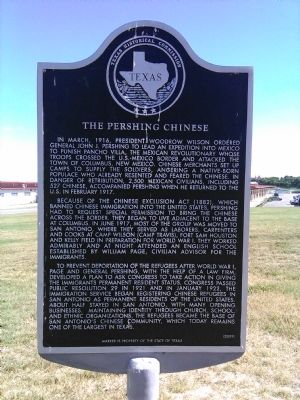Near East Side in Fort Sam Houston in Bexar County, Texas — The American South (West South Central)
The Pershing Chinese
In March, 1916, President Woodrow Wilson ordered General John J. Pershing to lead an expedition into Mexico to punish Pancho Villa, the Mexican revolutionary whose troops crossed the U.S.-Mexico border and attacked the town of Columbus, New Mexico. Chinese merchants set up camps to supply the soldiers, angering a native-born populace who already resented and feared the Chinese. In danger of retribution, 2,500 Mexican civilians, including 527 Chinese, accompanied Pershing when he returned to the U.S. in February 1917.
Because of the Chinese Exclusion Act (1882), which banned Chinese immigration into the United States, Pershing had to request special permission to bring the Chinese across the border. They began to live adjacent to the base at Columbus. In June 1917, most of the group was moved to San Antonio, where they served as laborers, carpenters and cooks at Camp Wilson (Camp Travis), Fort Sam Houston and Kelly Field in preparation for World War I. They worked admirably and at night attended an English school established by William Page, civilian advisor for the immigrants.
To prevent deportation of the refugees after World War I, Page and General Pershing, with the help of a law firm, developed a plan to ask Congress to take action in giving the immigrants permanent resident status. Congress passed Public Resolution 29 in 1921 and in January 1922, the Immigration Service began registering Chinese refugees in San Antonio as permanent residents of the United States. About half stayed in San Antonio, with many opening businesses. Maintaining identity through church, school, and ethnic organizations, the refugees became the base of San Antonio's Chinese community, which today remains one of the largest in Texas.
Erected 2009 by Texas Historical Commission. (Marker Number 16246.)
Topics. This historical marker is listed in these topic lists: Asian Americans • Government & Politics • Settlements & Settlers • War, World I. A significant historical month for this entry is January 1922.
Location. 29° 26.866′ N, 98° 26.617′ W. Marker is in Fort Sam Houston, Texas, in Bexar County. It is in the Near East Side. Marker is at the intersection of Wilson Street and Road S-22, on the right when traveling east on Wilson Street. Marker is in a field on the south side of the road. There is no parking close to the marker. Touch for map. Marker is in this post office area: Jbsa Ft Sam Houston TX 78234, United States of America. Touch for directions.
Other nearby markers. At least 8 other markers are within 2 miles of this marker, measured as the crow flies. Tether Wall (approx. 1.2 miles away); M-1905 Field Gun (approx. 1.2 miles away); M-56 Howitzer 105mm Towed (Yugoslavia) (approx. 1.2 miles away); Ft. Sam Houston Quadrangle and Staff Post (approx. 1.2 miles away); M-48 Medium Tank 90mm "Patton" (approx. 1.2 miles away); M-59 Armored Personnel Carrier (approx. 1.3 miles away); Bullis House (approx. 1.3 miles away); Belgian Transit of Venus Observation Site (approx. 1.4 miles away). Touch for a list and map of all markers in Fort Sam Houston.
More about this marker. Fort Sam Houston is an active military installation. Appropriate identification is required for access.
Credits. This page was last revised on February 2, 2023. It was originally submitted on July 15, 2015, by Lee Hattabaugh of Capshaw, Alabama. This page has been viewed 1,570 times since then and 113 times this year. Photo 1. submitted on July 15, 2015, by Lee Hattabaugh of Capshaw, Alabama. • Bernard Fisher was the editor who published this page.
Editor’s want-list for this marker. Wide shot of marker and its surroundings. • Can you help?
